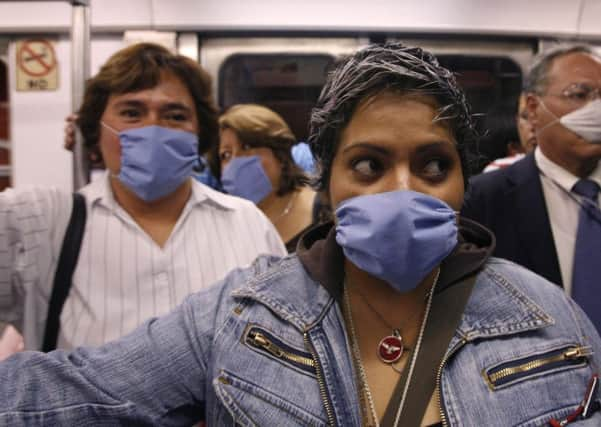Spanish Flu killed millions of people but when will the next pandemic strike?


During a TED talk in 2015, billionaire philanthropist Bill Gates told his audience: “When I was a kid, the disaster we worried about most was a nuclear war.” The Microsoft co-founder then added: “If anything kills over ten million people in the next few decades, it’s most likely to be a highly infectious virus, rather than a war. Not missiles, but microbes.”
It’s a sobering thought and one given credence by the fact the Government National Risk Register estimates that infectious diseases are an even greater potential threat since 2015, with fears that a pandemic flu virus could affect 50 per cent of the population.
Advertisement
Hide AdAdvertisement
Hide AdA hundred years ago this happened on a global scale, with devastating consequences. At the start of 1918, the Great War – which claimed the lives of more than 16 million men, women and children – was still raging. But it wasn’t the biggest killer that year. There was something even more deadly in the air than the hail of bullets, artillery fire and shrapnel – Spanish Flu.


It’s estimated that as many as one billion people, half the world’s population, were struck down by the Spanish flu pandemic. By the time the virus had swept across the planet it had claimed as many as 50 million lives – well over double the total number killed during the First World War.
The 1918 flu also killed more people than any other single outbreak of disease in history, surpassing even the Black Death which laid waste during the Middle Ages. The virus was thought to have originated in chickens and then mutated in pigs before emerging in humans in the early part of 1918. When soldiers started to succumb to the virus they were given rum, a standard cure-all on the Western Front.
The cruel irony was the death toll included many who had survived the horrors of battles like Passchendaele and the Somme only to be struck down by this unforgiving and indiscriminate virus. It was often lethally quick. It could start with a shivery twinge at breakfast and in some cases kill you before supper.
Advertisement
Hide AdAdvertisement
Hide AdThe illness reached our shores in the spring of 1918 and quickly spread, killing about 228,000 people within the first few months. Yorkshire didn’t escape its clutches. In Leeds alone it killed more than 1,400 people, with the Leeds General Cemetery Burial Registers showing a spike in the number of deaths caused by influenza that year.


Since then there have been three major flu pandemics the most recent of which was in 2009. The H1N1 virus, or swine flu as it was commonly called, first appeared in Mexico that year and rapidly spread around the world.
It was classed by the World Health Organization (WHO) as a global pandemic. Cases were confirmed in at least 171 countries and territories and the illness caused deaths in at least 139 of those.
Today, standards of living and medical care have improved immeasurably compared with a century ago. Nevertheless, health experts take the threat of a future pandemic seriously, pointing out it’s a case of when, rather than if, it happens.
Advertisement
Hide AdAdvertisement
Hide Ad“What is certain is we will have future flu pandemics, swine flu proved that. Whether it would be as devastating is a different question,” says Dr Mike Gent, assistant director of Health Protection of Public Health England for Yorkshire and the Humber. “We know the flu virus mutates and this happens regularly and that’s why the flu vaccine changes each year to keep up with those changes.”
The trouble comes when there’s a subtle mutation or one goes undetected that we have much less immunity to.
“It depends how nasty it is. Swine flu in 2009 wasn’t a particularly virulent pandemic but it was a new virus. If we were to get one that was virulent and hadn’t really been encountered before then we could get a lot more deaths.”
However, as Dr Gent points out we are better equipped to deal with a severe flu epidemic than society was in 1918. “If you think of the state of nutrition, housing and poverty at that time, it’s far different from what it is today.
Advertisement
Hide AdAdvertisement
Hide Ad“We now have fantastic health services in developed countries, there’s a population that is generally well nourished and living space is generally less cramped, which makes a potential virus less likely to spread. So even if people contract the illness they are more likely to withstand it because they’re healthier.”
On the flip side we have an increasingly ageing population in the western world. “We know that elderly people are more at risk from flu and its consequences, and while the general population is fairly fit because of advances in medicine we have more people who require regular medication to deal with different illnesses and they may be at greater risk.”
Along with concern over the virulence of any future virus, medical experts also have to contend with the fact they don’t know when, or where, a flu pandemic will occur. “It could happen tomorrow or it could be in another 20 years,” says Dr Gent.
“If you look back to 2009 we were all looking at H5N1 (bird flu) in South East Asia and wondering if a pandemic would arise from that, and then this one actually came out of Mexico. So predicting it just isn’t possible.
Advertisement
Hide AdAdvertisement
Hide Ad“What we have got in our favour is the WHO and a lot of public health services like Public Health England and CDC in America are looking out for it. The WHO is actively doing surveillance around the world which would hopefully give us a bit more warning of an impending pandemic.
“In 2009, we found out quite early on that it was a novel virus and it was passing from person to person. We had early warnings which gives you a bit of time to prepare.”
But given the recent well-publicised pressures on the NHS, any flu pandemic would stretch resources here. “If we do get a new virus it will still put a lot of pressure on health services even if it’s fairly mild.
“It also depends what time of year it strikes and it depends what else is going on.”
Advertisement
Hide AdAdvertisement
Hide AdEven so, Dr Gent says the UK is well placed to deal with a major flu outbreak in the future. “We were well prepared for the 2009 pandemic and since then we’ve built on that and learned a great deal. We’re better prepared now than we were at that point.”
One of the reasons why the 1918 virus became so far-reaching was it was spread by weary troops heading home at the end of the war.
Today, it’s not returning soldiers who are a problem but the huge growth in the number of people travelling by plane.
“What we learned from swine flu is the speed with which a virus can travel around the world because we’re so inter-connected.
Advertisement
Hide AdAdvertisement
Hide Ad“It could arise in another country and be in the UK 12 hours later. We could get less warning next time, which is why having these surveillance systems in place around the world is so important.”
The human cost of flu pandemics
The 1918 flu virus became known as Spanish Flu not because it started there but because while other countries suppressed news of the flu to avoid affecting morale, the press in Spain – which wasn’t involved in the conflict – were free to report on it, which it did.
As many as 50 million people were killed worldwide by what became known as Spanish Flu in 1918, including more than 228,000 in the UK. It’s estimated that 40 per cent of the world’s population was infected by the Asian flu epidemic of 1957.
In 1968 the Hong Flu killed up to three million people, with 30,000 deaths in the UK.
The 2009 swine flu outbreak started in Mexico and claimed about 200,000 lives around the world over the ensuing months.